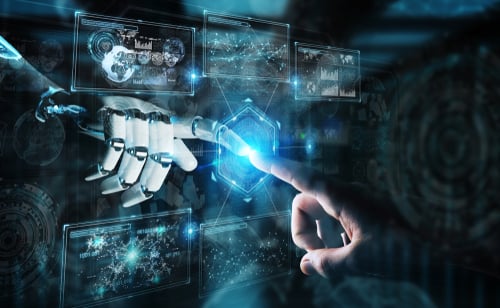 In an era where technology is advancing rapidly, businesses across diverse sectors are constantly seeking innovative solutions to streamline their processes, enhance productivity, and improve overall efficiency. The Human Machine Interface (HMI) is one such technology that has captured the attention of industries worldwide. This blog will dive into the fascinating world of HMI, exploring its fundamentals, applications, benefits, and the future of this extraordinary technology.
In an era where technology is advancing rapidly, businesses across diverse sectors are constantly seeking innovative solutions to streamline their processes, enhance productivity, and improve overall efficiency. The Human Machine Interface (HMI) is one such technology that has captured the attention of industries worldwide. This blog will dive into the fascinating world of HMI, exploring its fundamentals, applications, benefits, and the future of this extraordinary technology.
At its core, HMI refers to the point of interaction between humans and machines, systems, or devices. HMI encompasses both hardware and software components, enabling users to input commands, monitor, and control machinery or equipment effectively. Essentially, HMI serves as the bridge between human operators and the systems they manage, fostering seamless and efficient communication.
How Does Human-Machine Interface Work?
HMI systems employ a range of graphical interfaces, touch screens, buttons, and other input devices to facilitate user interaction. These interfaces often display real-time data, allowing users to monitor various aspects of the machinery or process in question, and make adjustments as needed. The HMI then communicates these commands to the machine or system, which, in turn, responds accordingly. HMI systems can be standalone, integrated into equipment or machinery, or accessed remotely via a computer, tablet, or smartphone.
HMI technology is revolutionizing the way we interact with machines, streamlining operations, and enhancing productivity across a wide range of industries. From manufacturing and transportation to healthcare and energy, the applications of HMI are virtually limitless. As HMI technology continues to evolve, we can expect even more sophisticated systems capable of facilitating more natural, intuitive, and efficient interactions between humans and machines.
HMI use-cases in different industries
Human Machine Interfaces find applications across a wide range of industries, including manufacturing, oil and gas, power generation, water treatment, and more. Some common uses of HMI systems include:
- Industrial automation: In manufacturing and other industrial settings, HMI systems help operators monitor and control automated processes, ensuring seamless production, improved safety, and reduced downtime.
- Building automation: HMI systems are used to manage heating, ventilation, air conditioning (HVAC), lighting, and other building systems, allowing facility managers to optimize energy usage and create an optimal environment for occupants.
- Healthcare: In medical environments, HMI systems allow healthcare professionals to monitor and control various medical devices, improving patient care and safety.
Benefits of HMI
Human Machine Interface (HMI) is an incredible technology that has the potential to reshape industries and redefine the way we interact with technology. By understanding the fundamentals of HMI and harnessing its power, businesses can unlock new levels of efficiency, productivity, and innovation.
Implementing HMI systems in various sectors comes with numerous advantages:
- Enhanced Efficiency: By providing real-time data and enabling easy monitoring and control of processes, HMI systems allow operators to optimize performance and reduce downtime. By automating repetitive tasks and streamlining processes, HMI systems allow businesses to improve productivity and achieve more outcomes with fewer resources.
- Increased Safety: With the real-time information provided by HMI systems, dangerous machinery malfunctions can be caught and dealt with ahead of time. HMI systems offer comprehensive and accurate readings of machinery operating status. With the visibility provided by HMI, companies that leverage this technology can improve the safety of both personnel and prevent costly machinery malfunctions.
- Reduced operating costs: HMI systems contribute to lower operational expenses by optimizing energy consumption, minimizing waste, and reducing maintenance requirements. Incorporating AI and machine learning: Integrating artificial intelligence and machine learning into HMI systems will empower them to analyze past interactions, anticipate user requirements, and deliver tailored context-sensitive support.
- Merging with AR and VR: The fusion of augmented reality and virtual reality technologies into HMI systems will transform user interaction with machines and equipment, providing immersive experiences and enriched training possibilities.
- Advancements in voice and gesture control: With ongoing improvements in voice recognition and gesture control technologies, HMI systems are likely to adopt these features, offering users more instinctive and organic ways to engage with machines and systems.
- IoT: The combination of HMI and Internet of Things technologies will facilitate smooth communication among devices, systems, and users, promoting increased automation, efficiency, and adaptability across various sectors.
- Enhanced Cybersecurity: As HMI systems become increasingly connected and data-driven, securing these interfaces against potential cyber threats will be crucial. Future developments in HMI technology will likely focus on robust security measures to protect sensitive information and maintain system integrity.
The Future of Human-Machine Interface Technology
As technological advancements progress, HMI systems are anticipated to evolve into more refined, intelligent, and user-centric solutions.
Human Machine Interface technology has made significant strides in revolutionizing how people interact with machines and systems, driving efficiency and productivity across multiple industries. As Encora continues to develop cutting-edge HMI solutions, they remain committed to helping businesses in Latin America (LatAm) and beyond harness the full potential of this transformative technology. Encora aims to empower companies with the tools and expertise needed to thrive in an increasingly competitive and technology-driven landscape by staying ahead of emerging trends and innovations.